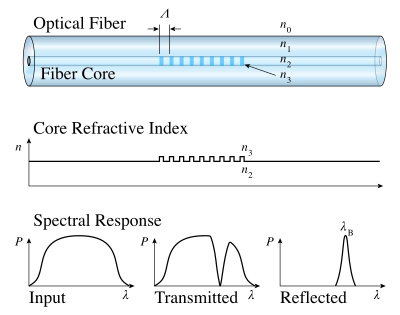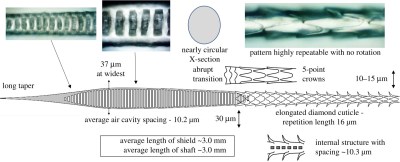If you’ve ever watched Predator, you’ve noted the tactical advantage granted to the alien warrior by its heat vision. Indeed, even with otherwise solid camoflauge, Dutch and his squad ended up very much the hunted.
And yet, back in reality, it seems the prey might be the one with the ability to sense in the infrared spectrum. Research has now revealed this unique ability may all be down to the hairs on the back of some of the smallest mammals.
Not By The Hair Of My Backy-Back-Back

Small mammals, like shrews and rodents, have fur that combines multiple types of hair into a thick protective coat. The fur must keep the animal warm, relatively dry, and protect it from the elements. But what if it could also protect against predators? For amongst this fur lie special “guard hairs” which researchers now believe act as finely tuned infrared sensors.
Guard hairs only make up maybe 1-3% of the fur. They usually stick out straight, protruding to a degree from the rest of the coat. They also tend to feature a rather distinctive banding pattern not seen on other types of mammalian hair.
For years, the periodic banding patterns observed in the guard hairs of small mammals puzzled scientists. These hairs exhibit internal bands spaced at intervals of 6-12 micrometers. If you’ve recently been staring at a chart of the electromagnetic spectrum, you might realize closely aligning with the wavelengths of infrared radiation. This hinted at an unrecognized function—an ability to sense infrared light, perhaps. Indeed, those wavelengths cover the same part of the infrared spectrum used by heat-seeking missiles and thermal imaging devices.
This was a feature with clear survival benefits for nocturnal and heavily predated animals. It could give a small creature the ability to detect warm heat sources—like a predator—approaching from behind. No need to have eyes on the back of one’s head, nor be forever looking over one’s shoulder. If your thermal sense picks up something warm approaching from behind, it might be worth making a dash action.
Researchers focused their guard hair research on three species: Mus musculus, the house mouse, Antechinus agilis, a mouse-like marsupial, and Sorex araneus, the common shrew. Despite the many differences amongst the species, the guard hairs share some similarities. Their findings showed that despite evolutionary divergences that stretch back millions upon millions of years, these species share highly similar microscopic hair structures that appear to be tuned to wavelengths between 8-12 um—perfect for thermal imaging.

Taking the house mouse as the main example, the hairs have a sophisticated structure. The wider sections of guard hairs, referred to as the the “shield,” are believed to act as infrared absorbers. They have a effectively two tubes joined by a membrane, with air cavities spaced at periodic intervals of approximately 10 um. Towards the base of the shield area, the hair narrows, and instead of air cavities, the hair features the characteristic dark bands with similar spacing. It’s believed the narrower sections help focus absorbed infrared energy into the base of the hair. A relatively variable “zipper” section then follows, with dark hemispheres arranged around the axis of the hair. This is believed to act as a “spectral filter” that radiates away wavelengths outside the 8-12 um band. Calculations suggest that the zipper filter means that infrared energy in that critical wavelength range makes up 72% of the “signal” reaching the base of the hair, rather than just 33% otherwise. The final section of the shaft has finer banding, at a spacing of just 6 um.

It’s believed that hairs act akin to infrared antennas—with their stiff, straight alignment and periodic banding enabling them to act as thermal detectors. The bands themselves appear to be made of infrared-transparent biological material of varying refractive indexes. Researchers liken this to a man-made invention called a fiber Bragg grating, or FBG. This device uses periodic variation in refractive index of an optical fiber to create a filter for a particular wavelength. Guard hairs could use a biological version of the same mechanism to filter out the infrared wavelength of interest.

Meanwhile, to pick up the signal, the animal would need some kind of sensor cell at the base of the hair. Indeed, researchers found that the house mouse does indeed have Merkel cells uniquely located at the base of guard hairs, arranged around the shaft. It’s believed these cells may be responsible for the actual infrared sense, with the hairs themselves just acting as antennas to focus the infrared energy to them.
The researchers also branched out, looking at whether predators may have adapted around this in turn. Notably, they found that cold-blooded snakes were virtually invisible in the thermal infrared range. Similarly, cats are relatively low in thermal emissions from the forward aspect. Both would thus have an advantage at hunting against mammals with a thermal sensing defence mechanism. And indeed, these creatures are particularly adept at hunting mice and other small mammals, as you’d expect!

The research is still at an early stage. Further work remains to confirm the true purpose of these guard hairs. Regardless, their complex microstructures do provide compelling evidence that they are indeed acting as antennas to capture infrared radiation for sensory purposes.
The discovery of these natural infrared sensors is not just a biological curiosity. It could also serve useful in the field of photonics. The guard hairs’ ability to act as finely tuned infrared antennas could potentially act as inspiration for new optical devices, or to improve on current technologies.

Additionally, this research could influence evolutionary biology, providing new insights into the ancient origins of mammalian and marsupial hair. Guard hairs’ resilience over millions of years suggests they played a crucial role in early mammalian survival, possibly dating back to the Triassic period.
In any case, certain tiny mammals have always been wildly capable at evading predators that sneak up from behind. We might now have a secret insight into this little party trick. Perhaps it was never their eyes, or a keen sense of vibration, but a hidden thermal sense that was lurking in the fur all along.
Featured image: “Lab mouse mg 3263” by [Rama]
















I used an IR led/sensor in a rodent trap. The video camera recorded one rat approaching in the dark, freezing and bolting away. No other beast ever came close again.
Different kind of IR. Rats are incredibly suspicious of novel items in their environment, which is why you check and replace traps/bait less often in a rat infestation than in a mouse infestation. Even adjusting the position slightly can spook them.
Most IR devices emit near-IR which is almost visible to the human eye, you can buy far-IR emitters that are further along the spectrum and from what I’ve heard many animals are not sensitive to them.
Looking forward to my bald spot becoming an infrared sensor via hair transplant!
Evolution took away your only defense.
Those poor bald mice.
Interesting, but you would think that an infrared sensor system like that would have been adapted by predators, it seems like it would be a real winner. I guess evolution doesn’t really have a game plan.
I would classify pit vipers (e.g. rattlesnakes) as predators, but they aren’t mammals.
And I don’t think their IR system uses hairs.
I don’t intend to get close enough to look.
B^))
Pretty sure cats have this sense too; they always find the warmest spot to nap
Assuming for now that keratin is even sufficiently transparent, is there experimental evidence for reciprocal effects? If so, one would expect to see with a thermal camera some of the body heat being emitted with an angular preference, e.g. towards the rear.
The hairs would also be best at detecting the polarization of the IR. Would being able to detect that too have any advantage to the mouse ?
Ugh. Ugh, ugh, ugh.
I’d really love for all this to be true, and the analysis of the hair structures is super-cool, but…
Do rodents ACTUALLY RESPOND to IR hitting these hairs? I mean, how hard could it be to rig up a test environment with a radiator that does (experimental) or doesn’t (control) crank out extra thermal photons, and see whether there’s any BEHAVIORAL EFFECT?
If the paper had started out with “it is well known that certain small animals respond to the approach of warm predators even in the absence of visual, auditory, or air-movement cues [list of references]”, I’d be 100% on board. But to propose a sensory system as elaborate as this, and NOT EVEN TRY to address WHETHER IT ACTUALLY DOES ANYTHING, seems completely preposterous.
Then again, I dropped out of academia not long after finishing a non-biology PhD, so what do I know about what makes a good paper?
” so what do I know about what makes a good paper?”
Well, I want one that doesn’t shred easily when I am trying to wipe, and soft and absorbent, leaving no unpleasant stuff behind (on my behind) and biodegrades in the septic system.
It’s starting to get thick in here….two ply?
I want to see behavioral effect and thermography, but to be fair detecting thermal infrared isn’t exactly an unheard of thing for skin to do – we do it, we just ignore it in modern life, and we don’t have hairs focusing it down.
Yeah, this really surprised me too. There are a couple of systems that track (laboratory) mice with near-IR imaging, e.g. commercial ones from Noldus (https://www.noldus.com/phenotyper) or DIY ones like the LiveMouseTracker (published in Nature Biomedical Engineering, see here: https://livemousetracker.org/).
I built one of the LiveMouseTrackers as my Covid lockdown research projects, they use a Microsoft Kinect v2 and a bit of machine learning to track up to 4 mice, and work quite well in practice. As far as I can tell the mice don’t mind being illuminated with the Kinect’s NIR point pattern, or in any case are more stressed by the presence of a human in the room.
Still, I think that the “specialized hairs are IR detectors” hypothesis is interesting. It’s probably not surprising that Physicists were the first to see this, given that they would have the relevant background knowledge. That said, I would like to see a follow-up project that uses physiological measurements of the Merkel cells with IR on or off – that would be indisputable evidence and could probably be done in ex vivo slice preparations too.
This was thermal infrared not near infrared though. ~10um vs ~1um.
they have the ability to feel warmth and this is surprising?
the hair warms and the follicle reacts
Reading this made the hairs on the back of my neck stand up.
Wait, what? Aaaaaaaaaaaaarrrrggghhh!”!!!!!